Good Posture Habits

Good posture is about more than standing up straight so you can look your best. It is an important part of your long-term health. Making sure that you hold your body the right way, whether you are moving or still, can prevent pain, injuries, and other health problems.
What is posture?
Posture, which is the relative disposition of the body at any one moment, is a composite of the positions of the different joints of the body at that time. The position of each joint influences the position of the other joints.
Correct posture – the position in which minimum stress is applied to each joint.
Faulty posture – any static position that increases the stress to the joints.
What causes posture problems?
Poor posture often stems from modern-day habits like working in front of a computer, slouching on a couch while watching TV, or looking down at a smartphone. Poor posture could also be due to many hours spent carrying heavy objects (like equipment at work, grocery bags, or a heavy purse).

All these activities can make you stoop or bring your shoulders forward. This overstretches and weakens the muscles in the back of your shoulders and shortens the muscles in the front of your shoulders and in your chest. Gravity then pulls the muscles forward, because the muscles
are too weak to pull them back up.
If the core muscles in your back and abdomen have grown weak from inactivity, that can also cause you to lean forward. Those muscles are crucial to lifting your frame and keeping you upright.
Another cause of poor posture comes from broken bones in your back. People with brittle bones may experience compression fractures when the bones in the back (vertebrae) aren’t strong enough to support the load placed on them. The bone collapses on the front side, the part closest to the chest. As collapsed vertebrae stack up, the spine becomes rounded and bends forward, a condition called dowager’s hump (dorsal kyphosis).
Poor posture can be bad for your health. Slouching or slumping over can:
- Misalign your musculoskeletal system
- Increase pressure on the spine, making it more prone to injury and degeneration
- Cause neck, shoulder, and back pain
- Decrease flexibility
- Affect how well joints move
- Affect balance and increase risk of falling
- Make it harder to digest food
- Induce breathing disorder and affect surrounding structures including the heart and phrenic nerve
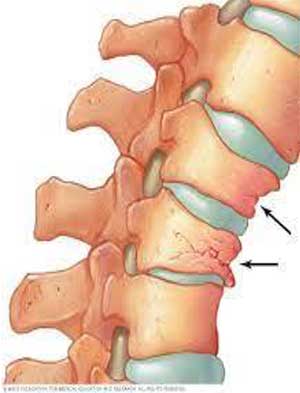
What should I do???
- Stay active. Any kind of exercise may help improve your posture, but certain types of exercises can be especially helpful. e.g., yoga, tai chi, and other classes that focuses on body awareness. It is also a good idea to do exercises that strengthen your core.
- Be mindful of your posture during everyday activities, like watching television, washing dishes, or walking.
- Maintain a healthy weight. Extra weight can weaken abdominal muscles, cause problems for pelvis and spine, and contribute to low back pain.
- Wear comfortable, low-heeled shoes. High heels, for example, can throw off balance and force person to walk differently. This puts more stress on muscles and harms posture.
- Make sure work surfaces are at a comfortable height for you, whether sitting in front of a computer, making dinner, or eating a meal.
- Remember to maintain a neutral posture as this helps body to function optimally
- Ensure to engage your core (example deep abdominal and pelvic floor muscles ) during strenuous activities and breath out as you lift. This helps to stabilize your spine


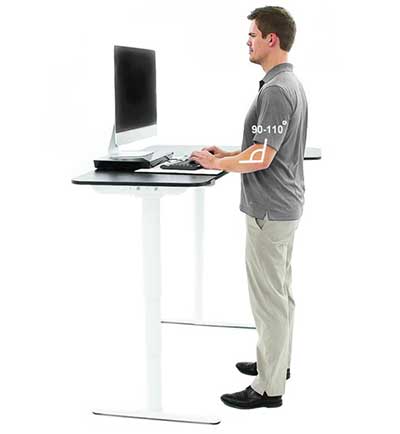
DESK ERGONOMIC ZONES:
Sit up straight and set your desk up so that the items you use the most are the closet to you or the “Frequent Zone”. Things you use less frequent are further away. You should be able to reach every item by only extending your arms in the “Frequent” and “Less Frequent Zones”. The rare zone can be out of arms reach which may require bending at the hips to reach.
DESK ERGONOMIC SET UP:
Sit at your desk on a comfortable and adjustable chair with back rest to maintain lumbar curvature and use an ergonomic keyboard. Do not slouch. Your desk should be set up so that the monitor is at or just below eye level. The elbows, hips and knees bent 90-110 degrees. Adjustments can be made for monitor height, keyboard height, seat height, desk height and/or footrest height in order to achieve proper alignment. Electronic desk is preferred if available to be able to adjust the height of the desk with buttons.
DESK ERGONOMIC SET UP IN STANDING:
Stand at your desk and use an ergonomic keyboard. Your desk should be set up so that the monitor is at or just below eye level. The elbow bent to approx. 90-110 degrees. Adjustments can be made for monitor height, keyboard height via desk height in order to achieve proper alignment. Electronic desk is preferred, if available, to be able to adjust the height of the desk with the push of a button.
COUNTERTOP WORK:
When working at a countertop, stand close to the counter to minimize bending at the waist. Maintain a straight spine.
BRUSHING TEETH:
When standing at a sink to brush teeth, open the cabinet door and place one foot on the shelf and avoid excessive bending at the waist. Maintain a straight spine. Use arm for support on countertop if needed for additional support
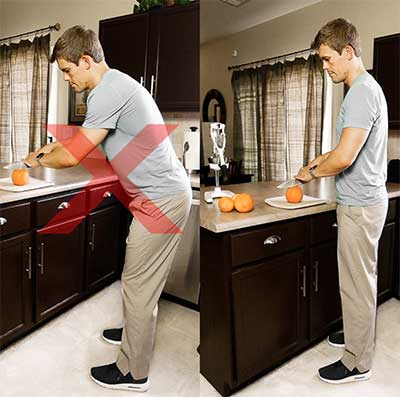

➢ Avoid static postures such as prolonged sitting and standing.
➢ Prolonged cross-legged sitting can lead to a bent and asymmetrical posture, especially for people with low back pain. Erect sitting for long hours can also cause postural problems. It is recommended to get up from your chair and move around at least every 30 minutes.
➢ Prolonged standing, usually at work, can lead to musculoskeletal pain and vascular disorders. Seated breaks are necessary to prevent the risk of causing associated pain or discomfort. When standing prolonged, place one foot on a step stool or raised surface. Alternate to the other foot from time to time. Keep your spine straight.

EVERYDAY EXERCISES TO IMPROVE POSTURE
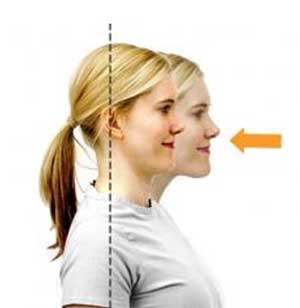
CERVICAL RETRACTION / CHIN TUCK:
Slowly draw your head back so that your ears line up with your shoulders. Hold this position for 5 seconds and return to normal position
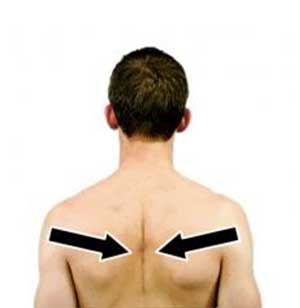
SCAPULAR RETRACTIONS
Move your shoulder blades back and down. Hold, relax and repeat.

SHOULDER ROLLS
Move your shoulders in a circular pattern as shown so that you are moving in an up, back and down direction. Perform small circles if needed for comfort.
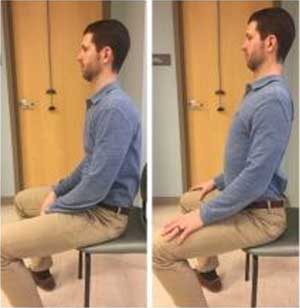
SLOUCH OVERCORRECT
While sitting on edge of chair, sit slouched, then overcorrect and sit as upright as possible. Hold for 5 seconds then return to starting position. On the last repetition during the full upright position, relax 10-20% so that it is more comfortable to maintain – this is ideal sitting posture. Perform throughout the day when sitting.
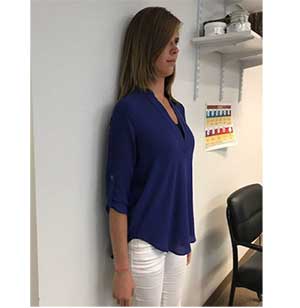
WALL POSTURE
Start standing with your back to a wall. Bring feet about 4-6 inches away from wall, but maintain your buttocks, mid-upper back, and head in contact with the wall and hold. Be sure not to tilt your head up, keep chin slightly tucked. Repeat several times.
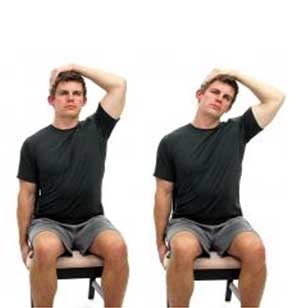
UPPER TRAP STRETCH
While sitting in a chair, hold the seat with one hand and place your other hand on your head to assist in bending your head to the side as shown. Bend your head towards the opposite side of the hand that is holding the chair seat. You should feel a stretch to the side of your neck. Hold, relax and repeat.

LEVATOR SCAPULAE STRETCH
Grab the chair seat and then tilt your head to the other side, then rotate to the side, then tip downward as in looking at your opposite pocket. Use your other hand and apply over pressure by gentling pulling. You should be looking towards your opposite pocket of the target side. Hold, relax and repeat.
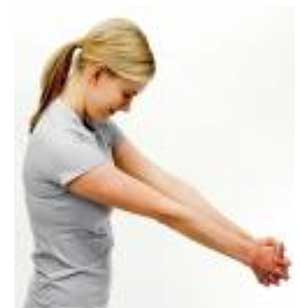
RHOMBOID AND MIDDLE TRAP STRETCH – CLASPED HAND
Interlace your fingers and then draw your hands forwards until a stretch is felt along your upper back.
NOTE: You can vary the angle of your arms downward to stretch different muscle fibers along your back.

PECTORALIS CORNER STRETCH
While standing at a corner of a wall, place your arms on the walls with elbows bent so that your upper arms are horizontal, and your forearms are directed upwards as shown. Take one step forward towards the corner. Bend your front knee until a stretch is felt along the front of your chest and/or shoulders. Your arms should be pointed downward towards the ground.
NOTE: Your legs should control the stretch by bending or straightening your front knee.

SINGLE KNEE TO CHEST STRETCH
While lying on your back, raise your leg up and hold your thigh under your knee while gently pulling it towards your chest for a gentle stretch. Lower your leg down and repeat.
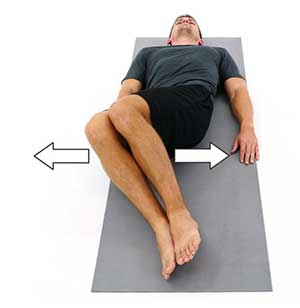
LOWER TRUNK ROTATIONS
Lying on your back with your knees bent, gently rotate your spine as you move your knees to the side and then reverse directions and move your knees to the other side. Repeat the move through a comfortable range of motion.
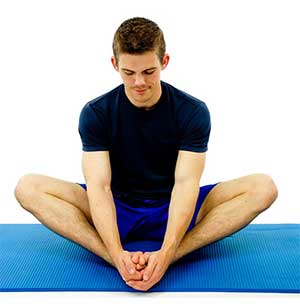
BUTTERFLY STRETCH
While in a sitting position, bend your knees and place the bottom of your feet together. Next, slowly let your knees lower towards the floor until a stretch is felt at your inner thighs.
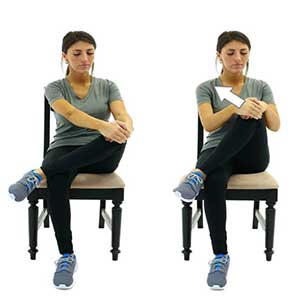
SEATED PIRIFORMIS STRETCH
While sitting in a chair, cross your leg and place the ankle of one foot on the knee of the other leg. Next, pull the top knee upward towards your opposite shoulder for a gentle stretch.

SEATED HAMSTRING STRETCH
Sit near the front edge of a chair. Rest your heel on the floor with your knee straight and gently lean forward until a stretch is felt behind your knee/thigh. Maintain a straight spine the entire time. Bend through your hips. Hold, relax and repeat
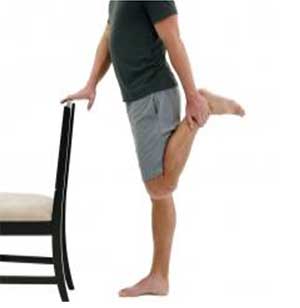
QUAD STRETCH – STANDING
While in a standing position, bend your knee back behind and hold your ankle/foot. Next, gently pull your knee into a more bent position until a stretch is felt on the front of the thigh. Hold, relax and repeat. Hold on to a stable surface to avoid falls.
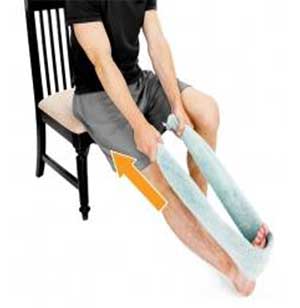
SEATED CALF STRETCH
While sitting, use a towel or other strap looped around your foot. Gently pull your ankle back until a stretch is felt along the back of your lower leg. Maintain your target knee straight the entire time. Hold, relax and repeat.
